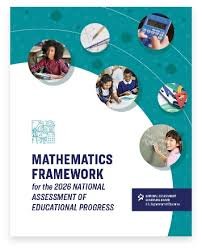Math Framework
NAEP Math Framework Cuz, the more ya know-
2024/2026
Number Properties and Operation (including computation and understanding of number concepts)
Quantitatively Order; Order continuous quantities- interest in Space, area, volume and Time.
Number Sense; Estimation; Comfort- “is a major expectation by 4th Grade” NAEP. i) Order rational or irrational numbers, including very large and very small real numbers. (Page 20 NAEP Math Framework 2026). A) Add and subtract- strategic decomposing and composing.
Order of number and Operations PEMDAS; Reasoning trends. Solve real world problems.
Ratios and proportional reasoning Apply basic properties of operations; Use proportions to solve problems (including rates of change and per capital problems) (pg 22)
Measurement (including use of instruments, application of processes, and concepts of area and volume)
Measuring physical attributes- compare world quantitatively; domain of whole numbers; Compare objects with respect to a given attribute, such as length, area, capacity, time, or temperature.
Systems of Measurement; Connection to measuring is vital to mapping space and time; c) Estimate measure in another system- Kilometer to mile; US dollars to Canadian dollars, Fahrenheit to Celsius. (Pg. 26)
Measurement in triangles to solve problems consistently using Sine, Cosine and Tangent as ratios of sides in a right triangle; Interpret Pythagorean theorem; Pi,
Geometry (including spatial reasoning and applying geometric properties)
Dimension and Shape- Land measurement; practical of rules- by 4th grade “expected to be familiar with a library of simple figures in space and plane.
Transformation of figures and preservation of properties; Mirrors historical development
Relationship between geometric figures; Preservation of properties to solve real-world problems. Analyze properties.
Position, direction- logical implications and conclusion regarding ratio. f) fin an equation of a circle given its center and radius and , given an equation of a circle, find its radius.)
Data Analysis, Statistics and Probability (including graphical displays)
Data representation include conversations the entire process of collecting, organizing, summarizing and interpreting data.
Characteristics of data sets; Interpret (mean, median, mode, range and standard deviation) Compare. Approximate trends; Predict; f) Recognize or explain how an argument based on data might confuse correlation with causation.
Experiments and Samples; Identify bias; Evaluate characteristics of experiments;
Probability- determine whether two events are independent or dependent; Using assumption, randomness, unfamiliar contexts, predict events. h) Determine the probability of independent and dependent events. *objectives that proved opportunities for questions in mathematical literacy. j) Interpret and apply probability concepts to practical situations, including odds of success or failure in simple lotteries or games of chance; K) use the binomial theorem to solve problems.
Algebra (including expressions, equations, representations, and relationships)
Patterns, relation, and functions; recognize and describe in words of symbols, numerical and visual patterns.
Algebraic representations; f) Given a real-world situation, determine if a linear, quadratic, rational, exponential, logarithmic, or trigonometric function fits the situation.
Variables, expressions and operations b) Write algebraic expressions, equations, or inequalities to represent a situation.
Equations and inequalities; b) Determine the role of hypothesis, logical implications, and conclusions in algebraic arguments about equality and inequality; h) Solve quadratic equations with complex roots.
Note: This is a culmination of 2020 Math Framework and Current adjustments.
